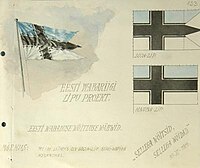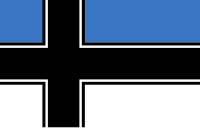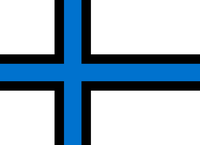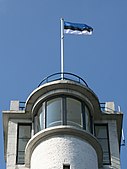Flag of Estonia
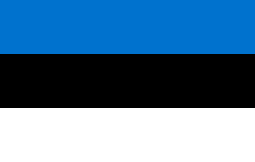 | |
| Sinimustvalge | |
| Use | Civil and state flag, civil ensign |
|---|---|
| Proportion | 7:11[1] |
| Adopted | 1918 |
| Design | A horizontal triband of blue, black, and white |
 | |
| Use | Naval ensign |
| Proportion | 7:13 |
| Adopted | 1991 |
| Design | Tricolour, swallowtail, defaced with the shield of the state arms off-set towards hoist. |
The national flag of Estonia (Estonian: Eesti lipp) is a tricolour featuring three equal horizontal bands of blue (top), black (middle), and white (bottom). In Estonian it is colloquially called the "sinimustvalge" (lit. 'blue-black-white').
The tricolour was already in wide use as the symbol of Estonia and Estonians when the country gained independence in 1918. Formally, the sinimustvalge became the national flag by the decision of the Estonian Provisional Government on 21 November 1918, and the flag's official status was reconfirmed by a law on 16 July 1922.[2] The tricolour was used as the national flag until June 1940 when the Soviet Union invaded and occupied Estonia. After the annexation of Estonia by the Soviet Union in August 1940, the use of the national tricolour and its blue, black and white colour combination was banned and punishable by law in the Soviet Union.[3] The national flag was from 1940 until 1991 continuously used by the Estonian government-in-exile, diplomatic service, and the Estonian diaspora around the world.
In October 1988, the usage of the blue-black-white flag was officially permitted again by Estonian authorities. On the evening of 23 February 1989 the Soviet flag was taken down permanently from the Pikk Hermann tower of Toompea Castle. It was replaced with the national blue-black-white flag on the next morning, 24 February, upon the 70th anniversary of the Estonian Declaration of Independence (1918). The national flag was officially re-adopted by the Estonian authorities 7 August 1990, one year before the nation's full restoration of independence.

Colours
The shade of blue is defined by Parliament and Government Office as follows:[1][5]
Symbolism

A symbolism-interpretation made popular by the poetry of Martin Lipp says the blue is for the vaulted blue sky above the native land, the black for attachment to the soil of the homeland as well as the fate of Estonians — for centuries black with worries, and white for purity, hard work, and commitment.[6]
Other current flags
History
This section needs additional citations for verification. (December 2013) |

In the 1820s, in the University of Tartu, three eponymous German-speaking student corporations (corps) were established for each of the three Baltic provinces (Estonia, Livonia and Curonia). Each of them selected their own "colours" (German: "Farben"; Estonian: "värvid") which, in turn, became flags and visual representations of the corresponding province. Public display (for example, as part of attire) of these colour combinations was often prohibited by the Imperial Russian authorities and, after the outbreak of World War I, finally and completely banned during the anti-German propaganda campaign in 1915.
In 1870, the predecessor of the Estonian Students' Society, the first indigenous Estonian-speaking student organisation, was established at the University of Tartu, and in 1881 it adopted a similar tricolour flag and set of three "colours": blue, black, and white. The selection of blue and white then was probably also motivated by the flag of Finns and, unlike the earlier corps' colour combinations, each one of the three colours of the new organisation was ascribed symbolic meanings.

The Estonian blue-black-white flag was therefore officially adopted first as a flag of a university student organisation on 17 September 1881 by the constituent assembly of the first indigenous student corps "Vironia" (modern Estonian Students' Society) in Tartu. The colours and the pattern chosen by the student society eventually became the national flag in the 20th century.[7]
The flag became associated with Estonian nationalism and was already used as the national flag (riigilipp) when the Estonian Declaration of Independence was issued on 24 February 1918. The first time the flag was raised as the national and state symbol atop of the Pikk Hermann tower in the capital city Tallinn was on 12 December 1918. The flag was formally made official by the national government on 16 July 1922.[8][9]
The invasion by the Soviet Union in June 1940 led to the flag's ban. It was taken down from the most symbolic location, the tower of Pikk Hermann in Tallinn, on 21 June 1940, when Estonia was still formally independent. On the next day, 22 June, it was hoisted along with the red flag. The tricolour disappeared completely from the tower on 27 July 1940, and was replaced by the Soviet flag.
During the German occupation from 1941 until 1944, the flag was accepted as the ethnic flag of Estonians but not the national flag. After the German retreat from Tallinn in September 1944, the Estonian tricolour was hoisted once again.
When the Red Army conquered Tallinn on 22 September 1944, the blue-black-white flag disappeared from the Pikk Hermann tower. Its place was then taken by the red Soviet flags until 1990. The blue-black-white flag remained illegal until the late 1980s. 21 October 1987 was the first time when Soviet forces did not take down the flag at a public event. 24 February 1989 the blue-black-white flag was again flown from the Pikk Hermann tower in Tallinn. It was formally redeclared as the national flag on 7 August 1990, little over a year before Estonia regained full independence.
Historical flags used prior to the flag of Estonia
Flag of the Danish Realm and its Duchy of Estonia (1219–1346)
Flag of the State of the Teutonic Order (1226–1561)
Flag of the Swedish Empire and its Duchy of Estonia (1561–1721)
Flag of the Governorate of Estonia (1796–1917)
Flag of the Governorate of Livonia (1796–1918)
Nordic flag proposals
Several Nordic cross designs were proposed already in 1919, prior to the official adoption of the Estonian state flag. In 2001, journalist Kaarel Tarand made a similar suggestion again – that the flag design be changed from a tricolour to a Nordic cross with the same three colours.[10] Supporters of this idea have claimed that the cross, instead of a tricolour design, would better symbolise Estonia's links with Nordic countries. However, as the traditional tricolour bands have by now become an important symbol of national identity, proposals to modify the national flag have not gained much popularity.
Advocates for a Nordic flag state that Estonians consider themselves a Nordic nation rather than Baltic,[11] based on their cultural and historical ties with Sweden, Denmark, and particularly Finland. In December 1999 Estonian foreign minister—later the Estonian president from 2006 to 2016—Toomas Hendrik Ilves delivered a speech entitled "Estonia as a Nordic Country" to the Swedish Institute for International Affairs.[12] Diplomat Eerik-Niiles Kross also suggested changing the country's official name in English and several other foreign languages from Estonia to Estland (which is the country's name in Danish, Dutch, German, Swedish, Norwegian and many other Germanic languages).[13][14]
Selections from the Estonian Flag Act
The most recent Estonian Flag Act was passed 23 March 2005 and came into force on 1 January 2006. It has been amended several times since then. The Act specifies the colours in Pantone and CMYK formats, as well as specifying when it can be hoisted and how it can be used and by whom. The minimum size of the flag to be hoisted on a wall-mounted flagstaff or on a flagpole on the roof of a building is 105 by 165 centimetres (41 in × 65 in). The Act specifies that the "Estonian flag is used as the ethnic and the national flag".[15]
More specifically, the Flag Act specifies that the flag be hoisted on the Pikk Hermann tower in Tallinn every day at sunrise, but not earlier than 7:00 a.m., and is lowered at sunset.[15] The flag flying days are:
- 3 January: Commemoration Day of Combatants of the Estonian War of Independence
- 2 February: Anniversary of Tartu Peace Treaty
- 24 February: Independence Day
- 14 March: Mother Tongue Day
- 23 April: Veterans' Day
- The second Sunday of May: Mothers' Day
- 9 May: Europe Day
- 1 June: Day for the Protection of Children
- 4 June: Flag Day
- 14 June: Day of Mourning
- 23 June: Victory Day
- 24 June: Midsummer Day
- 20 August: Day of Restoration of Independence
- 1 September: Day of Knowledge
- The second Sunday of September: Grandparents' Day
- The third Saturday of October: Finno-Ugric Day
- The second Sunday of November: Fathers' Day
- The day of election of the Riigikogu (parliament), the day of election of local councils, the day of a referendum and the day of election of the European Parliament.[15]
Gallery
The current flag above Pikk Hermann tower, Toompea castle, Tallinn
Flag of Estonia on top of Suur Munamägi watch tower, the highest point in Estonia, at 318 metres (1,043 ft) above sea level
Early morning fog in the Põhja-Kõrvemaa Nature Reserve
An Estonian cross flag used on the island of Vormsi
Jaan Künnap atop Ibn Sina peak, the first time the Estonian flag was displayed higher than 7,000 metres (23,000 ft)
See also
References
Citations
- ^ a b "Estonian Flag Act". Riigiteataja. Retrieved 24 March 2021.
- ^ "Riigi Teataja 6 juuli 1922 — DIGAR Eesti artiklid".
- ^ "Minevikuminutid: sinimustvalge oli okupatsioonivastane sümbol". ERR (in Estonian). 21 February 2018. Retrieved 12 September 2021.
- ^ "Estonia". fotw.info.
- ^ "Eesti lipp". Riigigantselei. Retrieved 24 August 2022.
- ^ "Flag of Estonia: History of the Estonian Flag". Estonian Free Press. Archived from the original on 2010-09-05. Retrieved 2019-01-31.
- ^ "Estonia's History". Estonia's History. December 3, 2013. Retrieved 2013-12-03.
- ^ "Estonia's Blue-Black-White Tricolour Flag". Estonian Embassy in Washington. January 1, 2007. Archived from the original on December 17, 2007. Retrieved 2009-04-26.
- ^ Greenberg & Mensing 2012, p. 10.
- ^ Tarand, Kaarel (December 3, 2001). "Lippude vahetusel" (in Estonian). Eesti Päevaleht. Archived from the original on January 26, 2008. Retrieved 2009-04-26.
- ^ "Estonian Life" (PDF). Estonian Ministry of Foreign Affairs. 2004. Archived from the original (PDF) on 2009-03-25. Retrieved 2009-04-26.
- ^ Ilves, Toomas Hendrik (December 14, 1999). "Estonia as a Nordic Country". Estonian Ministry of Foreign Affairs. Retrieved 2009-04-25.
- ^ Kross, Eerik-Niiles (November 12, 2001). "Estland, Estland über alles" (in Estonian). Eesti Päevaleht. Archived from the original on 2007-11-13. Retrieved 2009-04-25.
{{cite news}}: CS1 maint: bot: original URL status unknown (link) - ^ Representations on the Margins of Europe: Politics and Identities in the Baltic and South Caucasian States, Tsypylma Darieva, Wolfgang Kaschuba Campus, 2007, page 154
- ^ a b c "Estonian Flag Act". Riigi Teataja. Riigikantselei, Justiitsministeerium. 2018-06-25. Retrieved 2019-02-27.
General and cited references
- Faure, Gunter; Mensing, Teresa (2012). The Estonians; The long road to independence. Lulu.com. ISBN 9781105530036. - Total pages: 409
External links
- CS1 Estonian-language sources (et)
- Harv and Sfn no-target errors
- CS1 maint: bot: original URL status unknown
- Articles with short description
- Short description with empty Wikidata description
- Articles containing Estonian-language text
- Articles needing additional references from December 2013
- All articles needing additional references
- Articles containing German-language text
- Commons category link is locally defined
- Flags of Estonia
- Flags introduced in 1922
- Flags introduced in 1990
- National flags
- National symbols of Estonia








